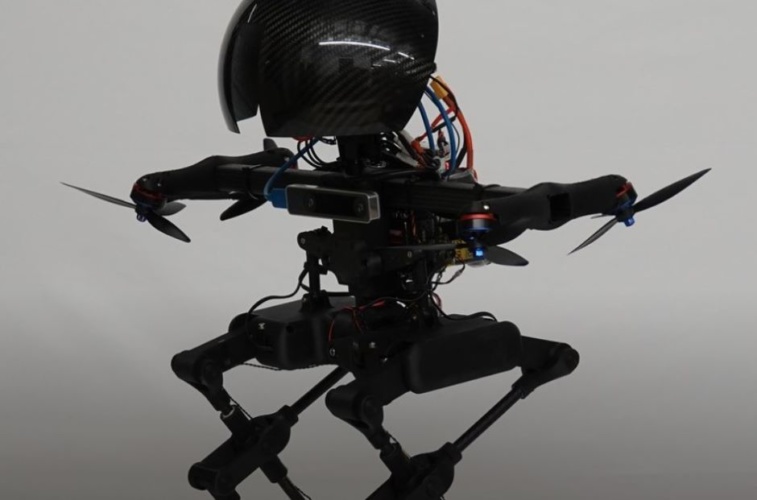According to CALTECH, LEONARDO (LEgs ONboARD drOne, or LEO) can walk a slackline, hop, and ride a skateboard. Developed at Caltech's Center for Autonomous Systems and Technologies (CAST), LEO is said to be the first robot that uses multi-joint legs and propeller-based thrusters to achieve a fine degree of control over its balance.
A paper detailing LEO was featured on the October 2021 cover of Science Robotics.
"We drew inspiration from nature. Think about the way birds are able to flap and hop to navigate telephone lines," said Soon-Jo Chung, corresponding author and Bren Professor of Aerospace and Control and Dynamical Systems. "A complex yet intriguing behaviour happens as birds move between walking and flying. We wanted to understand and learn from that."
"There is a similarity between how a human wearing a jet suit controls their legs and feet when landing or taking off and how LEO uses synchronised control of distributed propeller-based thrusters and leg joints," Chung added. "We wanted to study the interface of walking and flying from the dynamics and control standpoint."
Bipedal robots can tackle complex real-world terrains by using the same sort of movements as humans use but they are hindered by rough terrain. Flying robots easily navigate such terrain by avoiding the ground, but they face their own set of limitations in the form of high energy consumption during flight and limited payload capacity.
"Robots with a multimodal locomotion ability are able to move through challenging environments more efficiently than traditional robots by appropriately switching between their available means of movement. In particular, LEO aims to bridge the gap between the two disparate domains of aerial and bipedal locomotion that are not typically intertwined in existing robotic systems," said Kyunam Kim, postdoctoral researcher at Caltech and co-lead author.
LEO's lightweight legs are said to take stress off of its thrusters by supporting the bulk of the weight, but because the thrusters are controlled synchronously with leg joints, LEO has uncanny balance.

"Based on the types of obstacles it needs to traverse, LEO can choose to use either walking or flying, or blend the two as needed. In addition, LEO is capable of performing unusual locomotion manoeuvres that even in humans require a mastery of balance, like walking on a slackline and skateboarding," said co-lead author Patrick Spieler.
LEO stands 2.5 feet tall and is equipped with two legs that have three actuated joints, along with four propellers mounted at an angle at the robot's shoulders. When a person walks, they adjust the position and orientation of their legs to cause their centre of mass to move forward while the body's balance is maintained. LEO walks this way because the robot’s the propellers ensure it is upright as it walks, and the leg actuators change the position of the legs to move the robot's centre of mass forward through the use of a synchronised walking and flying controller. In flight, the robot uses its propellers and flies like a drone.
Next, the team plans to improve the performance of LEO by creating a more rigid leg design that is capable of supporting more of the robot's weight and increasing the thrust force of the propellers. They hope also to make LEO more autonomous so that the robot can understand how much of its weight is supported by legs and how much needs to be supported by propellers when walking on uneven terrain.
The researchers also plan to equip LEO with a newly developed drone landing control algorithm that utilises deep neural networks. With a better understanding of the environment, LEO could make its own decisions about the best combination of walking, flying, or hybrid motion that it should use to move from one place to another based on what is safest and what uses the least amount of energy.




Poll: Should the UK’s railways be renationalised?
I think that a network inclusive of the vehicles on it would make sense. However it remains to be seen if there is any plan for it to be for the...